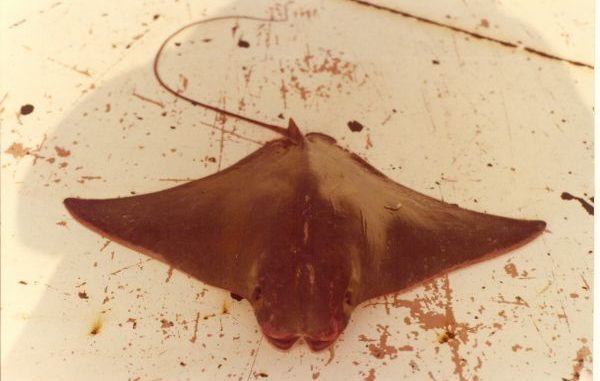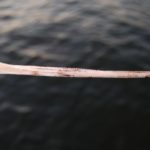
“Choo Choo!”
At least that is what some shrimpers say they hear. The animal that they have nicknamed “choo-choo” for the whoofing sound that it makes after it hits the deck of a shrimp boat is known by scientists as a cownose ray, Rhinoptera bonasus.
The scientific name is entirely derived from Greek. The genus name comes from rhinos, which means “nose” and pteron, which means “wing.” The species name comes from bonasos, which means “bison.”
Cownose rays get their name from their deeply indented head, which is unlike that of any of the other nine spine-bearing stingrays found in the northern Gulf of Mexico.
And, yes, in case you are curious, there is also a bullnose ray, but it is an entirely different species in a different family. But back to our guy!
Shrimpers see a lot of them. They are common, get through the turtle excluder devices in their nets because they are too big for fish excluders to release.
Shrimpers dislike them. They grow large, reaching 84 inches from wing tip to wing tip and over 50 pounds. As they flounce on the deck of the boat, they crush numbers of shrimp, so shrimpers naturally are quick to return these unwelcome guests to the water.
They also swim in large schools, so when a net encounters one, it most likely catches many.
Another reason to get them off the boat is that the spines on top of their tails can be dangerous to crewmen sorting the shrimp catch. The groove on the bottom of the spine holds mucous and toxins produced from a spongy venom gland under the spine.
Capt. John Smith, the English explorer who Pocahontas saved from execution by her Virginia Indian tribe, found out about cownose rays’ stingers the hard way, when during his 1608 voyage he was stung so badly that his crew thought he would die. The spot on the Rappahannock River where it happened is still known today as Stingray Point.
Because of their food habits, they are not likely to take a sports fisherman’s baited hook. But they are often seen by recreational anglers in coastal waters. They swim in large schools (an estimated 10,000 have been seen in one school), and they swim very close to the water’s surface.
Unlike other fish, which swim with a side-to-side motion, rays swim by flapping their wing-like pectoral fins up and down with a bird-like motion. This, their brown color and their tendency to swim very near the surface mean that their pectoral fin tips often break the water’s surface, looking uncannily like shark fins. Large schools present quite a spectacle.
So does their mating activity, which takes place from June through October. A female cownose ray will swim with the tips of pectoral fins out of the water. Up to six males will follow her, each trying to grasp a fin for mating. Major splashing can occur as the males jump out of the water in their attempts to grasp a fin with their mouths.
After mating, the gestation period is 11 to 12 months. They are ovoviviparous, meaning the female produces eggs that are retained in the body. The young hatch and, at first, live off the yolk sac of the egg. After this is gone, the female produces a thick, sticky fluid called “histotroph” to feed the young.
Life is tough inside the female. Only 1 living pup is produced per litter. This survivor has eaten not only any unfertilized eggs within the female, but its brothers and sisters, as well. At birth, pups average 14 inches across, but can be as large as 16 inches. Until birth, the pup’s sharp spine is covered with a protective sheath.
Unlike many fishes, which have a very fast growth rate when young and very little growth when old, research done in Louisiana shows that cownose rays grow at a fairly regular growth rate as they age, only slowing slightly after 12 years of age.
The oldest male cownose rays in the four-year Louisiana study were 16 years old and the oldest females were 18 years old. The rays were aged by counting the growth rings in thin slices of their cartilaginous spine. Both sexes matured at 4 to 5 years old.
The research also showed the rays were present in waters offshore of Louisiana in all months except December, January and February. None were found at water temperatures lower than 68° Fahrenheit.
Mass migrations of cownose rays have been observed on the Atlantic Coast — toward the south in the fall and northward in the spring. This and their absence here in the dead of winter support a water temperature-driven migration in the Gulf of Mexico, as well.
While cownose rays spend much of their time near the surface, they feed on the bottom, locating food by using their pectoral fins to stir up sand and mud, and sucking water and sediment into their mouths and out their gills. Food items are filtered out of this slurry and crushed between flat terrazzo-like teeth set on roller-like dental plates.
Cobia, a species that preys on small young cownose rays, have been observed closely following feeding adult rays to grab rejected or displaced food items.
Their diet consists heavily of clams and oysters, as well as snails, crabs, lobsters and even some finfish. This diet has landed them in trouble. While they seldom invade inshore waters in Louisiana, where the state’s oyster beds are, they do so in the Chesapeake Bay, where oyster populations are already in trouble because of pollution, disease and overharvest.
The Virginia Sea Grant Program has put a bounty on their heads by promoting a fishery for the big, brown rays to be used for human consumption. Cownose rays have blood-colored flesh, something hard for people used to white-fleshed fish to get used to.
Band saws are used to cut the pectoral fins from the body. Each fin is then filleted to remove the flesh from its upper and lower sides from the layer of tough cartilage that lies inside each fin. The texture of the flesh more closely resembles veal than fish.
Besides humans and cobia, cownose rays are preyed upon primarily by large sharks like hammerhead, bull and sandbar sharks.




